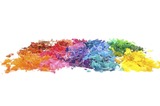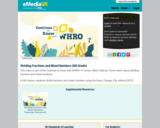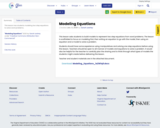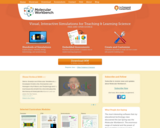
Modeling Division of Fractions Mathematics Instructional Plan
- Subject:
- Mathematics
- Material Type:
- Lesson Plan
- Provider:
- VDOE
- Author:
- VDOE
- Date Added:
- 10/07/2024

Modeling Division of Fractions Mathematics Instructional Plan

Modeling Multiplication of Fractions Mathematics Instructional Plan

5th grade students that are studying matter will be focusing in this lesson on the smallest unit of matter - the atom.
Students will use small marshmallows to construct a model of an atom.

This resource provides a 5E style lesson (Engage, Explore, Explain, Elaborate, Evaluate) over the rock cycle, including a single-period lab using crayons to model the cycle. It’s often a difficult concept for students to imagine that over millions of years, one kind of rock will change into another kind of rock. This lab allows students to see the changes taking place, and learn important qualities of each type of rock and how they are formed.Photo: Rainbow of Crayon Shavings by Richie Girardin via Flickr

This video is part of the Continue to Know with WHRO TV series. Watch Victoria Valenciana Brannen teach about creating and solving single-step practical problems involving addition, subtraction, and multiplication of decimals.

This video is part of the Continue to Know with WHRO TV series. Watch Kathryn Turner teach about dividing fractions and mixed numbers.

Science Instructional Plans (SIPs) help teachers align instruction with the Science Standards of Learning (SOL) by providing examples of how the content and the scientific and engineering practices found in the SOL and curriculum framework can be presented to students in the classroom.

Science Instructional Plans (SIPs) help teachers align instruction with the Science Standards of Learning (SOL) by providing examples of how the content and the scientific and engineering practices found in the SOL and curriculum framework can be presented to students in the classroom. This lesson focuses on the modeling of eclipses.This lesson includes the WIDA English Language Development Standards for ELs and differentiation through additional supports for both ELs and other students.

This lesson plan is about creating digital models in teaching phases of mitosis.

This lesson has students modeling two step equations to solve word problems.

This lesson has students modeling two step equations to solve word problems.

Created by the Concord Consortium, the Molecular Workbench is "a modeling tool for designing and conducting computational experiments across science." First-time visitors can check out one of the Featured Simulations to get started. The homepage contains a number of curriculum modules which deal with chemical bonding, semiconductors, and diffusion. Visitors can learn how to create their own simulations via the online manual, which is available here as well. The Articles area is quite helpful, as it contains full-text pieces on nanoscience education, quantum chemistry, and a primer on how transistors work. A good way to look over all of the offerings here is to click on the Showcase area. Here visitors can view the Featured simulations, or look through one of five topical sections, which include Biotech and Nanotechnology. Visitors will need to install the free Molecular Workbench software, which is available for Windows, Linux, and Mac.

Video Description: Learn about the global cooperation to build the International Space Station, or ISS. Use a simple scale model to demonstrate the amazing mathematical relationship between the Earth and moon and see how the low-Earth orbit of ISS compares. Video Length: 5:57.NASA eClipsTM is a suite of online student-centered, standards-based resources that support instruction by increasing STEM literacy in formal and nonformal settings. These free digital and downloadable resources inform and engage students through NASA-inspired, real-world connections.NASA eClips Our World videos (grades 3-5) help students understand the differences between science (the natural world) and engineering (the designed world). These video segments supplement elementary learning objectives not only in science, technology, engineering and mathematics, but also in reading, writing, visual and performing arts.

Video Description: Simple machines are all around us and help make our work easier. When simple machines are combined, a compound machine is created. Learn about NASA's compound machine, the lunar crane, and the simple machines it contains to make work easier in Our World. Video length: 4:17.NASA eClipsTM is a suite of online student-centered, standards-based resources that support instruction by increasing STEM literacy in formal and nonformal settings. These free digital and downloadable resources inform and engage students through NASA-inspired, real-world connections.NASA eClips Our World videos (grades 3-5) help students understand the differences between science (the natural world) and engineering (the designed world). These video segments supplement elementary learning objectives not only in science, technology, engineering and mathematics, but also in reading, writing, visual and performing arts.

Video Description: How does NASA test ideas, like the Mars Helicopter, before they are even built? Find out more about this revolutionary helicopter and how NASA uses mathematical modeling to turn complex ideas into solvable equations that help shape future missions. Video Length: 3:20.NASA eClipsTM is a suite of online student-centered, standards-based resources that support instruction by increasing STEM literacy in formal and nonformal settings. These free digital and downloadable resources inform and engage students through NASA-inspired, real-world connections.NASA eClips Real World segments (grades 6-8) connect classroom mathematics to 21st Century careers and innovations. They are designed for students to develop an appreciation for mathematics through real-world problem solving.

Video Description: Balancing Earth's incoming and outgoing energy is like balancing an equation. When both are equal, Earth's energy is in balance. Learn more about how changes in this balance may impact Earth. Video Length: 2:56.NASA eClipsTM is a suite of online student-centered, standards-based resources that support instruction by increasing STEM literacy in formal and nonformal settings. These free digital and downloadable resources inform and engage students through NASA-inspired, real-world connections.NASA eClips Real World segments (grades 6-8) connect classroom mathematics to 21st Century careers and innovations. They are designed for students to develop an appreciation for mathematics through real-world problem solving.

Video Description: Earth's energy balance is very delicate. Small changes may have a big impact. How might changes in Earth's land and atmosphere impact this delicate balance? How might this knowledge be used to help us take better care of Earth? Video Length: 2:31.NASA eClipsTM is a suite of online student-centered, standards-based resources that support instruction by increasing STEM literacy in formal and nonformal settings. These free digital and downloadable resources inform and engage students through NASA-inspired, real-world connections.NASA eClips Real World segments (grades 6-8) connect classroom mathematics to 21st Century careers and innovations. They are designed for students to develop an appreciation for mathematics through real-world problem solving.

Video Description: At NASA everything begins with an idea. Physical models help NASA engineers and technicians test those ideas before building full-scale versions. Learn more about the important role physical modeling, building prototypes and mathematics play in engineering solutions. Video Length: 3:11.NASA eClipsTM is a suite of online student-centered, standards-based resources that support instruction by increasing STEM literacy in formal and nonformal settings. These free digital and downloadable resources inform and engage students through NASA-inspired, real-world connections.NASA eClips Real World segments (grades 6-8) connect classroom mathematics to 21st Century careers and innovations. They are designed for students to develop an appreciation for mathematics through real-world problem solving.

Video Description: What defines the limits of the solar system? Where does the Oort Cloud fit within this defined space? Paul Chodas, from NASA's Near Earth Object Program, answers these questions and fills us in on some of NASA's missions and explorations that have helped shape our understanding of the solar system. Video Length: 2:22.NASA eClipsTM is a suite of online student-centered, standards-based resources that support instruction by increasing STEM literacy in formal and nonformal settings. These free digital and downloadable resources inform and engage students through NASA-inspired, real-world connections.NASA eClips Real World segments (grades 6-8) connect classroom mathematics to 21st Century careers and innovations. They are designed for students to develop an appreciation for mathematics through real-world problem solving.

Video Description: Paul Chodas, Manager for NASA's Near Earth Object Program, explains Astronomical Units (AUs) and how this unit of measure helps simplify an understanding of distances within the solar system. To further simplify thinking about these vast distances, distances within the solar system are explained scaled to the size of a football field. Video Length: 2:25.NASA eClipsTM is a suite of online student-centered, standards-based resources that support instruction by increasing STEM literacy in formal and nonformal settings. These free digital and downloadable resources inform and engage students through NASA-inspired, real-world connections.NASA eClips Real World segments (grades 6-8) connect classroom mathematics to 21st Century careers and innovations. They are designed for students to develop an appreciation for mathematics through real-world problem solving.